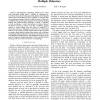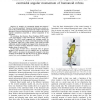516 search results - page 18 / 104 » Motion Planning of Legged Robots |
CEC
2009
IEEE
14 years 2 months ago
2009
IEEE
— Automatically synthesizing behaviors for robots with articulated bodies poses a number of challenges beyond those encountered when generating behaviors for simpler agents. One ...
ICRA
2002
IEEE
14 years 25 days ago
2002
IEEE
This paper describes a multi-layered hierarchical motion planning strategy for a class of self-reconfigurable modular robotic systems, I-Cubes. The approach is based on the synthe...
ICRA
2007
IEEE
14 years 2 months ago
2007
IEEE
Abstract— A number of conceptually simple but behaviorrich “inverted pendulum” humanoid models have greatly enhanced the understanding and analytical insight of humanoid dyna...
ICRA
2010
IEEE
13 years 5 months ago
2010
IEEE
To build autonomous robots capable to plan and control tasks in human environments, we need a description of trajectories that allows the robot to reason on his moves. In this pape...
GECCO
2009
Springer
14 years 2 months ago
2009
Springer
Embodied cognition emphasizes that intelligent behavior results from the coupled dynamics between an agent’s body, brain and environment. In response to this, several projects h...


